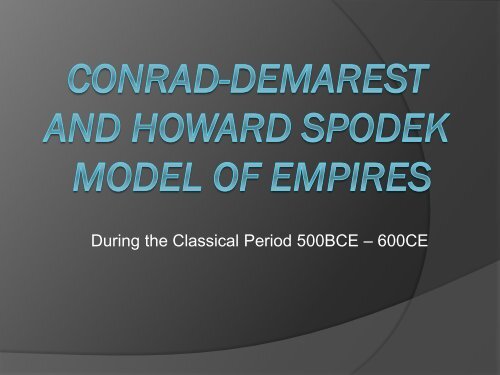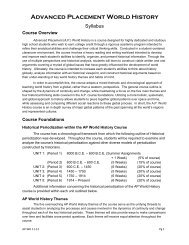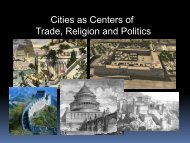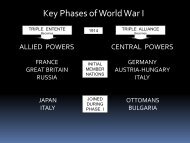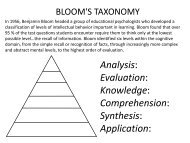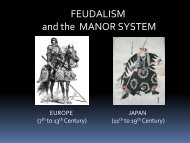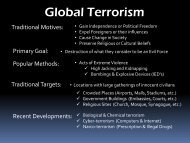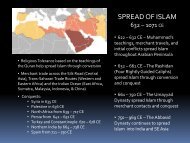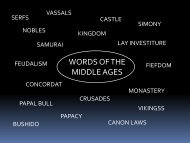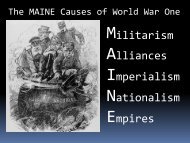The Demorest Model of Classical Empires
The Demorest Model of Classical Empires
The Demorest Model of Classical Empires
You also want an ePaper? Increase the reach of your titles
YUMPU automatically turns print PDFs into web optimized ePapers that Google loves.
During the <strong>Classical</strong> Period 500BCE – 600CE
According to Ge<strong>of</strong>frey Conrad, Arthur Demarest and Howard Spodek<br />
What is an Empire?<br />
• An Empire is a politically unified state in which one people dominate their<br />
neighbors through the use <strong>of</strong> various forces (military, trade, religion, etc.)<br />
According to Ge<strong>of</strong>frey Conrad and Arthur Demarest<br />
What Pre-Conditions needed to exist ?<br />
State-Level Government (Centralized & Bureaucratic)<br />
High Agricultural Potential (To Support a Large Population)<br />
An Environmental Mosaic (Diverse landscape and resources)<br />
Power Vacuum <strong>of</strong> Several Smaller and Weaker States<br />
Mutual Antagonism among the Small States<br />
Adequate Military Resources (Technological Advantage)
Case Study: Achaemenid or Persian Empire<br />
550 – 330 B.C.E.
Case Study: Existing Pre-Conditions<br />
• Diverse Environmental Mosaic<br />
Mountains, Valley Plateaus,<br />
Deserts, Thick Forests,<br />
Arable Lands, surrounded by<br />
various bodies <strong>of</strong> water<br />
• Region ruled by four kingdoms in decline<br />
Median Kingdom (612 – 549 BCE)<br />
Lydian Kingdom (687 – 546 BCE)<br />
Chaldean Kingdom (626 – 539 BCE)<br />
Egyptian Kingdom (685 – 525 BCE)<br />
• Weak rulers and<br />
conflicts between<br />
existing kingdoms<br />
• Many groups with<br />
horses and<br />
Equestrian skills<br />
• Plenty <strong>of</strong> arable<br />
lands to feed both<br />
people and animals
Case Study: Existing Pre-Conditions<br />
• Each kingdom already had established governmental controls<br />
Local satraps (governors)<br />
Regulated Taxes & Coinage<br />
Standardized Laws<br />
Urban trade centers<br />
Regional Capitols<br />
Various Military Forces
According to Ge<strong>of</strong>frey Conrad and Arthur Demarest<br />
What State Ideologies needed to exist ?<br />
Empire building succeeds if the State has an ideology that<br />
promotes personal identification with the Empire, Ruler, Military,<br />
and Conquest<br />
Case Study: Persian State Ideologies<br />
• <strong>The</strong> Rise <strong>of</strong> a Military Genius known as<br />
Cyrus II or Cyrus the Great<br />
• He demonstrated benevolence and<br />
kindness to all the people he conquered<br />
• He believed in honoring local customs and<br />
religious practices<br />
• He adopted and adapted local bureaucratic<br />
systems, standardized laws, and taxes
Case Study: Persian State Ideologies<br />
• Cyrus the Great established<br />
an elite military force called<br />
the Ten Thousand Immortals<br />
• Soldiers from all conquered<br />
areas were <strong>of</strong>fered the<br />
opportunity to enter the ranks<br />
<strong>of</strong> the Persian Army<br />
• <strong>The</strong> ideology <strong>of</strong> Militarism became the foundation <strong>of</strong> the Persian <strong>Empires</strong><br />
continual expansion and success under Kings Cambyses, Darius and Xerxes<br />
• According to the Behistun Text (522-486 BCE)<br />
the support <strong>of</strong> Zoroastrianism and other faiths<br />
promoted local acceptance <strong>of</strong> Persian rulers<br />
• In 539 BCE, Cyrus the Great freed the Jews<br />
in Egypt & allowed them to return to Babylon<br />
• Darius II promoted to co-existence <strong>of</strong> religions<br />
within the Persian Empire
According to Howard Spodek<br />
What were the Characteristics <strong>of</strong> well-run<br />
<strong>Empires</strong>?<br />
<strong>Empires</strong> required a massive bureaucracy to govern over diverse<br />
people within a single region<br />
<strong>Empires</strong> needed extensive transportation and communications<br />
networks<br />
<strong>Empires</strong> needed to regulate trade and establish a common currency<br />
for use throughout the region<br />
<strong>Empires</strong> needed to establish a unified legal system and method for<br />
collecting taxes<br />
<strong>Empires</strong> needed to maintain a strong military to protect trade,<br />
enforce laws, and defend the empire from both external and internal<br />
enemies
Case Study: Characteristics <strong>of</strong> Persian Empire<br />
• <strong>The</strong> Royal Road was a major<br />
highway updated by Darius I to<br />
facilitate communication, trade,<br />
and military movements within<br />
the empire (5 th Century BCE)
Case Study: Characteristics <strong>of</strong> Persian Empire<br />
• <strong>The</strong> Royal Road also connected the<br />
Persian <strong>Empires</strong> three Major Centers<br />
<strong>of</strong> Power<br />
Persepolis<br />
Babylon<br />
Susa
Case Study: Characteristics <strong>of</strong> Persian Empire<br />
• Standardized currency was also<br />
used to highlight successful<br />
military troops and campaigns<br />
• Persian rulers used gold & and<br />
silver coins with their likeness on<br />
them to represent their power and<br />
authority to rule over their subjects<br />
• Persian elites considered trade to be a pr<strong>of</strong>ession <strong>of</strong> lies and deceit<br />
• Most Persian communities and estates were self-sufficient<br />
• Local merchants and traders continued to deal with trade along key routes:<br />
Silk Road (East)<br />
Trans-Arabian (West)<br />
Red Sea Maritime Trade (West)<br />
Mediterranean Coastal Trade (Northwest)
Case Study: Characteristics <strong>of</strong> Persian Empire<br />
• Persian rulers continued to use the<br />
standardized laws <strong>of</strong> Hammurabi’s Code<br />
that had been adopted by most kingdoms<br />
throughout the region<br />
• 23 regional Satraps (Governors) were<br />
appointed to continue colleting taxes<br />
and enforcing laws<br />
• Military Officers and Government Officials<br />
traveled from town to town to conduct<br />
periodic audits<br />
• Adoption <strong>of</strong> the Aramaic language as the<br />
<strong>of</strong>ficial language <strong>of</strong> the Empire helped to<br />
unify the majority <strong>of</strong> native people
According to Ge<strong>of</strong>frey Conrad and Arthur Demarest<br />
What were the Major Results <strong>of</strong> <strong>Empires</strong>?<br />
Economic Rewards granted to elites (Trickle Down effect)<br />
Relative Stability and Prosperity Occurs<br />
Population Increases<br />
Case Study: Results in the Persian Empire<br />
• Increased economic and political rewards to local leaders who<br />
promoted tolerance and maintained law & order<br />
• Economic stability due to standardized coinage, taxes, and trade<br />
• Successfully governed over 35 million subjects for 300 years
According to Ge<strong>of</strong>frey Conrad and Arthur Demarest<br />
Why did <strong>Empires</strong> Fall?<br />
Failures <strong>of</strong> Leadership (Greed, Tyranny, Loss <strong>of</strong> Focus)<br />
Overextension (Excessive conquests beyond state’s capabilities)<br />
Lack <strong>of</strong> Conquests (Inactivity erodes military base & faith in Ideologies)<br />
Rebellions or Invasions (Internal or External Challenges to Power)<br />
Case Study: <strong>The</strong> Fall <strong>of</strong> the Persian Empire<br />
• Greco-Persian Wars (499 – 449 BCE) extended the Persian Empire into the<br />
Greek City-States creating a long standing rivalry between Persia & Greece<br />
• Artaxerxes came to the throne (358 BCE) through various plots that resulted<br />
in assassinations and suicide (2 brothers and 8 half-brothers died)
Case Study: <strong>The</strong> Fall <strong>of</strong> the Persian Empire<br />
• Internal Rebellions occurred in 343 BCE when Phoenicia, Asia Minor and<br />
Cyprus declared themselves independent<br />
• Extreme punishments and persecutions were imposed on Egypt for<br />
supporting various rebellions <strong>of</strong> neighboring kingdoms<br />
• <strong>The</strong> Conquests <strong>of</strong> Alexander the Great against King Darius III at the Battles <strong>of</strong><br />
Granicus (334 BC),<br />
Issus (332 BC) and<br />
Gaugamela (331 BC)


